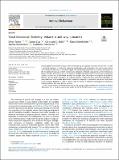Files in this item
Vocal functional flexibility : what it is and why it matters
Item metadata
| dc.contributor.author | Taylor, Derry | |
| dc.contributor.author | Clay, Zanna | |
| dc.contributor.author | Dahl, Christoph D. | |
| dc.contributor.author | Zuberbühler, Klaus | |
| dc.contributor.author | Davila-Ross, Marina | |
| dc.contributor.author | Dezecache, Guillaume | |
| dc.date.accessioned | 2022-03-11T10:30:20Z | |
| dc.date.available | 2022-03-11T10:30:20Z | |
| dc.date.issued | 2022-04 | |
| dc.identifier | 278227565 | |
| dc.identifier | d49c6c39-fb03-490e-915c-652ee9001d9c | |
| dc.identifier | 85125889838 | |
| dc.identifier | 000798824000009 | |
| dc.identifier.citation | Taylor , D , Clay , Z , Dahl , C D , Zuberbühler , K , Davila-Ross , M & Dezecache , G 2022 , ' Vocal functional flexibility : what it is and why it matters ' , Animal Behaviour , vol. 186 , pp. 93-100 . https://doi.org/10.1016/j.anbehav.2022.01.015 | en |
| dc.identifier.issn | 0003-3472 | |
| dc.identifier.other | RIS: urn:C01BD3AC24FDD7ED93EB6F1D6DFA93D7 | |
| dc.identifier.uri | https://hdl.handle.net/10023/25029 | |
| dc.description | The primary funder of this research was the ‘University of Portsmouth, Department of Psychology’ and the grant ID is ‘PhD Bursary’ which was awarded to ‘Derry Taylor’. | en |
| dc.description.abstract | Human speech is marked by a signal–function decoupling, the capacity to produce sounds that can fulfil a variety of functions, in contrast to nonverbal vocalizations such as laughter, cries and screams, which are functionally more rigid. It has been argued that this decoupling provides an essential foundation for the emergence of language, in both ontogeny and phylogeny. Although language has a deep evolutionary history, whether this capacity for vocal functional flexibility also exists in the vocal systems of nonhuman animals has been much overlooked. Reasons are multiple. Here, we propose to diagnose the problems that have thus far hindered progress on understanding the evolutionary basis of functional flexibility, an issue which can shed broader light on the evolution of language. In particular, we aim to clarify what vocal functional flexibility is, why it matters, why we believe it should be investigated in nonhuman animals and how this could be best achieved. | |
| dc.format.extent | 8 | |
| dc.format.extent | 364614 | |
| dc.language.iso | eng | |
| dc.relation.ispartof | Animal Behaviour | en |
| dc.subject | Communication | en |
| dc.subject | Comparative | en |
| dc.subject | Evolution | en |
| dc.subject | Language | en |
| dc.subject | Ontogeny | en |
| dc.subject | Referentiality | en |
| dc.subject | BF Psychology | en |
| dc.subject.lcc | BF | en |
| dc.title | Vocal functional flexibility : what it is and why it matters | en |
| dc.type | Journal item | en |
| dc.contributor.institution | University of St Andrews. School of Psychology and Neuroscience | en |
| dc.contributor.institution | University of St Andrews. Institute of Behavioural and Neural Sciences | en |
| dc.contributor.institution | University of St Andrews. Centre for Social Learning & Cognitive Evolution | en |
| dc.identifier.doi | 10.1016/j.anbehav.2022.01.015 | |
| dc.description.status | Peer reviewed | en |
This item appears in the following Collection(s)
Items in the St Andrews Research Repository are protected by copyright, with all rights reserved, unless otherwise indicated.

